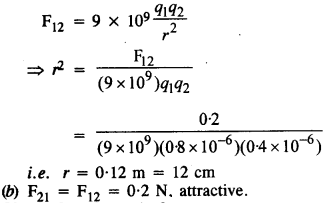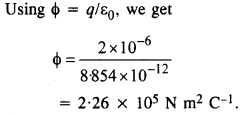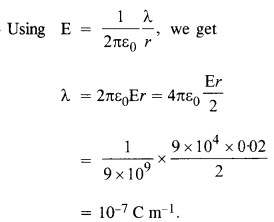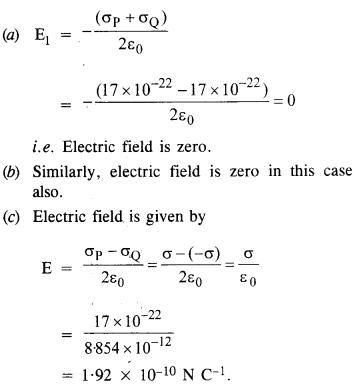NCERT Solved Exercise Questions – Class 12 Physics Chapter 1 Electric Charges And Fields
Topics and Subtopics in NCERT Solutions for Class 12 Physics Chapter 1 Electric Charges And Fields:
| Section Name | Topic Name |
| 1 | Electric Charges And Fields |
| 1.1 | Introduction |
| 1.2 | Electric Charge |
| 1.3 | Conductors and Insulators |
| 1.4 | Charging by Induction |
| 1.5 | Basic Properties of Electric Charge |
| 1.6 | Coulomb’s Law |
| 1.7 | Forces between Multiple Charges |
| 1.8 | Electric Field |
| 1.9 | Electric Field Lines |
| 1.10 | Electric Flux |
| 1.11 | Electric Dipole |
| 1.12 | Dipole in a Uniform External Field |
| 1.13 | Continuous Charge Distribution |
| 1.14 | Gauss’s Law |
| 1.15 | Applications of Gauss’s Law |
1.1 What is the force between two small charged spheres having charges of 2 × 10–7C and 3 × 10–7C placed 30 cm apart in air?
Ans – The formula used to find the force, F is given as

1.2 The electrostatic force on a small sphere of charge 0.4 µC due to another small sphere of charge –0.8 µC in air is 0.2 N.
(a)What is the distance between the two spheres?
What is the force on the second sphere due to the first?
Ans – (a) Electrostatic force on the first sphere, F = 0.2 N
Charge on this sphere, q1 = 0.4 μC = 0.4 × 10−6 C
Charge on the second sphere, q2 = − 0.8 μC = − 0.8 × 10−6 C

Both the spheres attract each other with the same force. Therefore, the force on the second sphere due to the first is 0.2 N.
1.3 Check that the ratio ke2 /G memp is dimensionless. Look up a Table of Physical Constants and determine the value of this ratio. What does the ratio signify?
Ans – Hence, the given ratio is dimensionless.
e = 1.6 × 10−19 C
G = 6.67 × 10−11 N m2 kg-2
me= 9.1 × 10−31 kg
mp = 1.66 × 10−27 kg

1.4 (a) Explain the meaning of the statement ‘electric charge of a body is quantised’.
(b) Why can one ignore quantisation of electric charge when dealing with macroscopic i.e., large scale charges?
Ans – (A) A body’s electric charge is quantized. The only number of electrons that can be transported from one body to another is the integral (1, 2,…, n) number of electrons. There is no fractional transfer of charges. As a result, a body only has integral multiples of electric charge in its overall charge.
(b) Compared to the size of the electric charge, the charges used in macroscopic or large-scale charges are enormous. Therefore, on a macroscopic scale, quantization of electric charge is useless. As a result, it is disregarded and it is assumed that electric charge is constant.
1.5 When a glass rod is rubbed with a silk cloth, charges appear on both. A similar phenomenon is observed with many other pairs of bodies. Explain how this observation is consistent with the law of conservation of charge.
Ans – Because charges are produced in pairs, rubbing results in charges on the two bodies that are of same magnitude but opposite kind. Charging by friction is the name given to this charging phenomena. The two rubbing bodies together have no net charge. This is due to the fact that equal numbers of opposing charges cancel each other out. A silk fabric is used to massage a glass rod, and opposite-natured charges develop on both bodies. The law of energy conservation is consistent with this event. Many other pairs of bodies exhibit a similar phenomena.
1.6 Four point charges qA = 2 µC, qB = –5 µC, qC = 2 µC, and qD = –5 µC are located at the corners of a square ABCD of side 10 cm. What is the force on a charge of 1 µC placed at the centre of the square?
Ans – The symmetry of the diagram makes it evident that the equal charges of 2C put at A and C will exert equal and opposing forces on the 1C charge. Similar to this, the -5 C charges at D and B will exert equal and opposing forces on the 1 C charge.

Force of repulsion between charges placed at corner A and centre O is equal in magnitude but opposite in direction relative to the force of repulsion between the charges placed at corner C and centre O. Hence, they will cancel each other. Similarly, force of attraction between charges placed at corner B and centre O is equal in magnitude but opposite in direction relative to the force of attraction between the charges placed at corner D and centre O. Hence, they will also cancel each other. Therefore, net force caused by the four charges placed at the corner of the square on 1 μC charge at centre O is zero.
1.7 (a) An electrostatic field line is a continuous curve. That is, a field line cannot have sudden breaks. Why not?
(b) Explain why two field lines never cross each other at any point?
Ans – (a) Because a charge receives a continuous force as it is traced in an electrostatic field, an electrostatic field line is a continuous curve. Because the charge goes continually and does not jump from one spot to another, the field line cannot abruptly break.
(b) The electric field intensity will exhibit two directions at a site where two field lines intersect. This cannot be done. Two field lines so never cross one another.
1.8 Two point charges qA = 3 µC and qB = –3 µC are located 20 cm apart in vacuum.
(a)What is the electric field at the midpoint O of the line AB joining the two charges?
If a negative test charge of magnitude 1.5 × 10–9 C is placed at this point, what is the force experienced by the test charge?
Ans – (a)


(b) A test charge of amount 1.5 × 10−9 C is placed at mid-point O.
q = 1.5 × 10−9 C
Force experienced by the test charge = F
∴F = qE
= 1.5 × 10−9 × 5.4 × 106
= 8.1 × 10−3 N
The force is directed along line OA. This is because the negative test charge is repelled by the charge placed at point B but attracted towards point A.
1.9 A system has two charges qA = 2.5 × 10–7 C and qB = –2.5 × 10–7 C located at points A: (0, 0, –15 cm) and B: (0,0, +15 cm), respectively. What are the total charge and electric dipole moment of the system?
Ans – Clearly, the given points are lying on the z-axis.
Distance between charges, 21

= 15 + 15 = 30 cm = 0.3 m
Total charge = (2.5 x 10-7) – (2.5 x 10-7) = 0
Dipole moment
= q x 21 = 2.5 x 10-7 x 0.3
= 7.5 x 10-8 C m along negative z-axis.
1.10 An electric dipole with dipole moment 4 × 10–9 C m is aligned at 30° with the direction of a uniform electric field of magnitude 5 × 104 NC–1 . Calculate the magnitude of the torque acting on the dipole.
Ans – Electric dipole moment, p = 4 × 10−9 C m
Angle made by p with a uniform electric field, θ = 30°
Electric field, E = 5 × 104 N C−1
Using τ = pE sin 0, we get
= (4 x 10-9) (5x 10-4 sin 30°)
= 2 x 10-4 x 12 = 10-4 N m 2
1.11 A polythene piece rubbed with wool is found to have a negative charge of 3 × 10–7 C.
(a)Estimate the number of electrons transferred (from which to which?)
(b) Is there a transfer of mass from wool to polythene?
Ans – (a) When polythene is rubbed against wool, a number of electrons get transferred from wool to polythene. Hence, wool becomes positively charged and polythene becomes negatively charged.

(b) Yes.
There is a transfer of mass taking place. This is because an electron has mass,
me = 9.1 × 10−3 kg
Total mass transferred to polythene from wool,
m = me × n
= 9.1 × 10−31 × 1.85 × 1012
= 1.706 × 10−18 kg
1.12 (a) Two insulated charged copper spheres A and B have their centres separated by a distance of 50 cm. What is the mutual force of electrostatic repulsion if the charge on each is 6.5 × 10–7 C? The radii of A and B are negligible compared to the distance of separation.
(b) What is the force of repulsion if each sphere is charged double the above amount, and the distance between them is halved?
Ans-

1.13 Suppose the spheres A and B in Exercise 1.12 have identical sizes. A third sphere of the same size but uncharged is brought in contact with the first, then brought in contact with the second, and finally removed from both. What is the new force of repulsion between A and B?
Ans – Step 1: The uncharged sphere is brought in contact with sphere 1. Since sphere 1 has charge ‘q’, it gets distributed among sphere 1 and sphere 3.
Now, charge on sphere 1 = q/2
Charge on sphere 2 = q/2
At this point the sphere 3 which was initially uncharged has a charge “q/2”.
Step 2: Now sphere 3 is brought in contact with sphere 2 due to which 1/4 × q will flow from sphere 2 to sphere 3. Now sphere 2 and sphere 3 have “3/4 × q” charge.
Now, q1 = ½ × 6.5 × 10-7 C
⇒ 3.25× 10-7 C
q2 = ¾ × 6.5× 10-7 C
⇒ 4.87 × 10-7 C
q3 = ¾ × 6.5× 10-7 C
⇒ 4.87 × 10-7 C

1.14 Figure 1.33 shows tracks of three charged particles in a uniform electrostatic field. Give the signs of the three charges. Which particle has the highest charge to mass ratio?

Ans – Similar charges repel one another whereas opposite charges attract one another. Particles 1 and 2 can be seen to travel in opposite directions, repelling from the negatively charged plate and moving towards the positively charged plate. These two particles therefore have a negative charge. Additionally, particle 3 may be shown to migrate in the direction of the negatively charged plate and repel away from the positively charged plate. Particle 3 is hence positively charged.
The displacement or degree of deflection for a given velocity is exactly related to the charge to mass ratio (emf). Particle 3 has the largest charge to mass ratio because it exhibits the greatest deflection.
1.15 Consider a uniform electric field E = 3 × 103 î N/C.
(a)What is the flux of this field through a square of 10 cm on a side whose plane is parallel to the yz plane?
(b) What is the flux through the same square if the normal to its plane makes a 60° angle with the x-axis?
Ans – (a)

1.16 What is the net flux of the uniform electric field of Exercise 1.15 through a cube of side 20 cm oriented so that its faces are parallel to the coordinate planes?
Ans – A cube’s faces are all parallel to its axes of coordinates. Because of this, the quantity of field lines piercing the cube and entering it is the same. As a result, there is no net flux through the cube.
1.17 Careful measurement of the electric field at the surface of a black box indicates that the net outward flux through the surface of the box is 8.0 × 103 Nm2/C.
(a) What is the net charge inside the box?
(b) If the net outward flux through the surface of the box were zero, could you conclude that there were no charges inside the box? Why or Why not?
Ans – (a) Using φ = φ /ε0 we get q =φ ε0
= (8 x 103) (8.854 x 10-12)
= 70.8 x 10-9 C = 0.07 μC
(b) It is not possible to say this because the box may include an equal number of positive and negative elementary changes. The net charge inside the box can only be stated to be zero.
1.18 A point charge +10 µC is a distance 5 cm directly above the centre of a square of side 10 cm, as shown in Fig. 1.34. What is the magnitude of the electric flux through the square? (Hint: Think of the square as one face of a cube with edge 10 cm.)

Ans – We know that,
Flux, Ø = q/ε …(1)
Where, q = net charged enclosed
ε0 = permittivity of free space
ε0 = 8.85× 10-12 N-1 m-2C2
Now plugging the values of q and ε0 in equation (2)

⇒ Ø = 11.28 × 105 Nm-2C-1
We understand that flux through all the faces of cube will be equal;
Let flux through the square = Øa
Hence,
Øa = Ø/6
Explanation: The net flux will be distributed equally among all 6 faces of the cube. Hence, the square will have one sixth of the total flux.
Øa = 1.88 Nm-2C-1
1.19 A point charge of 2.0 µC is at the centre of a cubic Gaussian surface 9.0 cm on edge. What is the net electric flux through the surface?
Ans –

1.20 A point charge causes an electric flux of –1.0 × 103 Nm2 /C to pass through a spherical Gaussian surface of 10.0 cm radius centred on the charge.
(a) If the radius of the Gaussian surface were doubled, how much flux would pass through the surface?
(b) What is the value of the point charge?
Ans – (a) The Gaussian surface’s surrounding charge is the only factor affecting the electric flow, which makes the surface’s size irrelevant. The new Gaussian surface’s electric flow is constant
i.e. -1 x 103 Nm2 C-1 because the charge enclosed remains same in this case also.
(b) Using φ = q/ε0, we get q = ε0 φ = (8.85 x 10-12) (-1 x 103)
i.e. q = -8.85 x 10-9 C.
1.21 A conducting sphere of radius 10 cm has an unknown charge. If the electric field 20 cm from the centre of the sphere is 1.5 × 103 N/C and points radially inward, what is the net charge on the sphere?
Ans –

1.22 A uniformly charged conducting sphere of 2.4 m diameter has a surface charge density of 80.0 µC/m2 .
(a) Find the charge on the sphere.
(b) What is the total electric flux leaving the surface of the sphere?
Ans – a) Let charge on sphere = q
We understand that,
Total charge, Q = Surface charge density× surface area.
Surface area of sphere, S = 4πr2
S = 18.08 m2
Q = 80× 10-6Cm-2× 18.08m-2
⇒ Q = 1.447 × 10-3C
b) Let total electric flux leaving the surface of sphere =
We know that,
Flux, Ø = q/ε0 …(1)
Where, Q = net charged.
ε0 = permittivity of free space
ε0 = 8.85× 10-12 N-1 m-2C2
By, plugging the values of q and ε0 in equation (1), we get,(b)

1.23 An infinite line charge produces a field of 9 × 104 N/C at a distance of 2 cm. Calculate the linear charge density.
Ans –

1.24 Two large, thin metal plates are parallel and close to each other. On their inner faces, the plates have surface charge densities of opposite signs and of magnitude 17.0 × 10–22 C/m2 . What is E:
(a) in the outer region of the first plate,
(b) in the outer region of the second plate, and
(c) between the plates?
Ans –

1.25 An oil drop of 12 excess electrons is held stationary under a constant electric field of 2.55 × 104 NC–1 (Millikan’s oil drop experiment). The density of the oil is 1.26 g cm–3. Estimate the radius of the drop. (g = 9.81 m s–2; e = 1.60 × 10–19 C).
Ans – When an oil drop is stationary, its net force must be zero or zero as the sum of all its forces. The weight of the oil drop or the force from Earth’s gravity, which is dragging it vertically downwards, and the electrostatic force, which is working in an upward direction, are the two forces acting on the oil drop. So that they cancel each other out, the two forces must be equivalent in strength and moving in the opposite direction.

1.26 Which among the curves shown in Fig. 1.35 cannot possibly represent electrostatic field lines?


Ans – (a) Because field lines must be normal to the conductor’s surface, the field lines depicted in (a) are not electrostatic field lines.
(b) Due to the fact that the field lines in (b) cannot originate from a negative charge and cannot end at a positive charge, they are not electrostatic field lines.
(c) Electrostatic field lines are represented by the field lines in (c). This is due to the field lines’ ability to resist one another after emerging from positive charges.
(d) The field lines depicted in (d) are not electrostatic field lines since they shouldn’t cross one another.
(e) Because closed loops do not develop in the region, the field lines seen in (e) are not electrostatic field lines.
1.27 In a certain region of space, electric field is along the z-direction throughout. The magnitude of electric field is, however, not constant but increases uniformly along the positive z-direction, at the rate of 105 NC–1 per metre. What are the force and torque experienced by a system having a total dipole moment equal to 10–7 Cm in the negative z-direction ?
Ans –

1.28 (a) A conductor A with a cavity as shown in Fig. 1.36(a) is given a charge Q. Show that the entire charge must appear on the outer surface of the conductor. (b) Another conductor B with charge q is inserted into the cavity keeping B insulated from A. Show that the total charge on the outside surface of A is Q + q [Fig. 1.36(b)].
(b) A sensitive instrument is to be shielded from the strong electrostatic fields in its environment. Suggest a possible way.

Ans – Choose a Gaussian surface that is completely inside the conductor yet extremely close to its surface.
(a) Since there is no electric field within the conductor, there is no electric flux across the Gaussian surface, or in other words, there is no net charge within the Gaussian surface. The charge is therefore said to be on the conductor’s outer surface, which is outside the Gaussian surface.
(b) A charge q inside the cavity will cause a charge -q on the cavity’s inside, causing a charge +q to show up on the outside. As a result, the total charge is (q + Q).
(c) To counteract the effects of the electrostatic field, the instrument should be encased in a metallic shell.
1.29 A hollow charged conductor has a tiny hole cut into its surface. Show that the electric field in the hole is (σ/2ε0 ) nˆ , where nˆ is the unit vector in the outward normal direction, and σ is the surface charge density near the hole.
Ans – (a) In this instance, a conductor with an empty cavity is given a charge Q on its outer surface. We must demonstrate that all of the charge only exists on the exterior surface and that there is no charge present on the interior surface.
According to the Gauss Theorem, the net electric flow across a Gaussian surface enclosing a charge equals the net charge divided by the permittivity of empty space.
b) Again using Gauss Theorem we know,
If electric field at all the points on a Gaussian surface is zero then the net charge enclosed by the Gaussian surface is also zero, or there is no charge inside the Gaussian surface
1.30 Obtain the formula for the electric field due to a long thin wire of uniform linear charge density E without using Gauss’s law. [Hint: Use Coulomb’s law directly and evaluate the necessary integral.]
Ans –



1.31 It is now established that protons and neutrons (which constitute nuclei of ordinary matter) are themselves built out of more elementary units called quarks. A proton and a neutron consist of three quarks each. Two types of quarks, the so called ‘up’ quark (denoted by u) of charge + (2/3) e, and the ‘down’ quark (denoted by d) of charge (–1/3) e, together with electrons build up ordinary matter. (Quarks of other types have also been found which give rise to different unusual varieties of matter.) Suggest a possible quark composition of a proton and neutron.
Ans –

1.32 (a) Consider an arbitrary electrostatic field configuration. A small test charge is placed at a null point (i.e., where E = 0) of the configuration. Show that the equilibrium of the test charge is necessarily unstable.
(b) Verify this result for the simple configuration of two charges of the same magnitude and sign placed a certain distance apart.
Ans – (a) Assume for the purposes of demonstrating the conclusion that the test charge at the null point is in a stable equilibrium. If this is the case, the test charge should return to its original position after being moved significantly away from the null point. It means that there will be a net inward flux of the electric field through the surface of a closed surface drawn around the test charge. Since it doesn’t contain any charge, Gauss law states that there can’t be any electric flux through its surface. Therefore, the test is invalid and our assumption.
(b) At a specific distance, two charges with the same magnitude and sign are put. The null point is the intersection of the joining lines of the charges. A restoring force is applied to a test charge when it is moved along the line. The net force pulls something away from the null point if it is displaced perpendicular to the joining line. The charge is unstable as a result since maintaining balance calls for restoring force in all directions.
1.33 A particle of mass m and charge (–q) enters the region between the two charged plates initially moving along x-axis with speed vx (like particle 1 in Fig. 1.33). The length of plate is L and an uniform electric field E is maintained between the plates. Show that the vertical deflection of the particle at the far edge of the plate is qEL2/(2m vx 2 ). Compare this motion with motion of a projectile in gravitational field discussed in Section 4.10 of Class XI Textbook of Physics.
Ans – Mass of the particle = m
Charge of the particle = -q
Velocity of the particle = vx
Length of the plate = L
Electric field between the plates = E
From Newton’s second law of motion

1.34 Suppose that the particle in Exercise in 1.33 is an electron projected with velocity vx = 2.0 × 106 m s–1. If E between the plates separated by 0.5 cm is 9.1 × 102 N/C, where will the electron strike the upper plate? (|e|=1.6 × 10–19 C, me = 9.1 × 10–31 kg.)
Ans –





